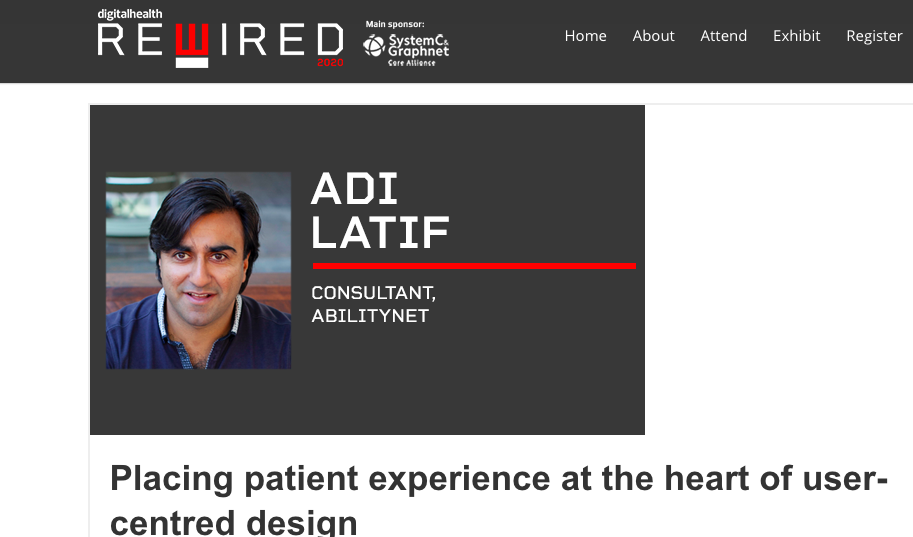How digital health excludes disabled people: Digital Health Rewired 2020
Sarah Botterill | 04 Mar 2020The NHS is still largely paper-powered, and that is excluding people with disabilities says AbilityNet’s Accessibility and Usability Consultant Adi Latif.
 Adi was speaking at the second day of Digital Health Rewired 2020, the show that connects current and future health leaders with the best in disruptive digital health.
Adi was speaking at the second day of Digital Health Rewired 2020, the show that connects current and future health leaders with the best in disruptive digital health.
Diagnosed at age 8 with a condition called Retinitis Pigmentosa, Adi recalled his early experiences as a visually-impaired healthcare user.
“The doctors would nod their heads and hand Mum a prescription and do all the transactional stuff while I would walk around the sweet aisle; I wasn’t able to understand prescriptions, and I didn’t know what was going on.”
Healthcare services are excluding the visually-impaired
 As a visually-impaired adult, Adi said it remains difficult accessing primary care.
As a visually-impaired adult, Adi said it remains difficult accessing primary care.
“I am thrown back into the dark when it comes to my healthcare,” said Adi. “My independence is stripped away because NHS communication is primarily paper-based.
He continued: "It is bad for the environment and worst of all it makes me disabled.”
Adi is not alone; a recent RNIB survey found that 86% of people who are visually-impaired cannot find information on their healthcare.
“Prescriptions are usually handed to you on a piece of paper,” said Adi. “I spent five years not knowing what the side-effects of a medication I was taking were."
"On another occasion, I had just done a test and a nurse handed me a letter, I asked for an electronic copy so I could use my screen reader.
"She said she didn’t know why I needed it as the letter was for my GP.”
Digital transformations are required by law
 Positive changes are coming, however.
Positive changes are coming, however.
For example, one of the stands we visited included IMMJ Systems, which is helping Healthcare Trusts digitise records at scale.
The main driver is to free up space, and create digital records but it also means that anyone – including those with a visual impairment – can submit a Subject Access Request (SAR) and see this in an accessible format under GDPR.
As Adi pointed to in his speech, the Accessible Information Standard (AIS) introduced by the government in 2016 requires that people with a disability or sensory loss are given information in a way they can understand.
It is now the law for the NHS and adult social care services to comply with AIS.
Video GP appointments in Boots
Elsewhere, Swedish-born LIVI – a company that enables you to see a video GP in minutes is discussing its recent partnership with Boots.
LIVI MD Juliet Bauer, formerly, NHS England's Chief Digital Officer said they’d be piloting the use of LIVI in Boots stores to drive “transformational change”.
“At no point should we send a customer away. Using LIVI, we can stop 80 people from every Boots store going back into the system [by offering an online GP appointment],” said Richard Corbridge, director of innovation and high street healthcare, Boots UK.
As well as being available in store you can access LIVI via its app.
How AbilityNet can help Digital Transformation
- Sign-up for our webinars to find out how you can make digital services accessible to all
- Talk to our experts about how we can ensure you're meeting accessibility standards
- Subscribe to our accessibility podcast
- Meet the clients we've already helped



